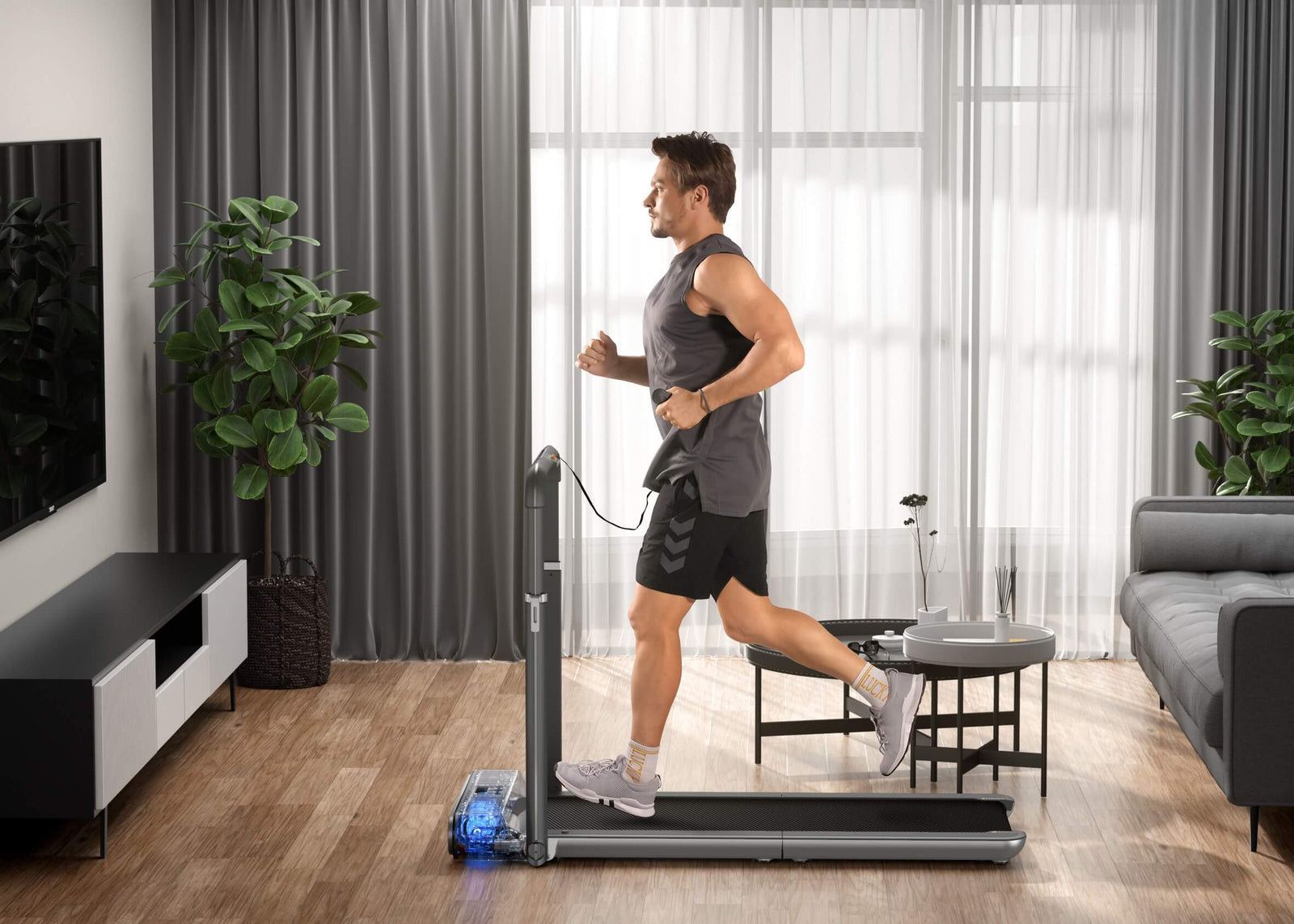Staying active is one of the cornerstones of long term health, but for many people, concerns about joint strain, particularly on the knees, can hold them back from maintaining a consistent exercise routine. You may have watched joggers pacing through London’s leafy parks or seen brisk walkers making the most of the British countryside and wondered whether there’s a safer, more joint-friendly alternative. This is where the treadmill often enters the conversation. But is it really better for your knees than pounding the pavements or uneven outdoor paths? To answer that, we need to look beyond the surface and explore both the science and the practical realities.
Quick Answer: Is a Treadmill Better for the Knees?
In most cases, yes, a treadmill is often gentler on the knees than walking or running on hard outdoor surfaces such as pavement or concrete. The main reason is that quality treadmills are designed with integrated cushioning and shock-absorption systems, which help reduce the impact force that normally travels up through your joints. That said, the benefit isn’t automatic. It depends on the treadmill’s build quality, how consistently it’s maintained, how you use it, and of course, your own joint health and biomechanics.
Why Do Knees Hurt During Exercise?
Before deciding whether a treadmill is the better option, it helps to understand why knee pain is so common in the first place. The knees are among the body’s most complex joints, designed to bear heavy loads and absorb repeated impact during weight-bearing activities. When strain outweighs support, discomfort often follows. Some of the most common causes include:
Impact Force: Every time your foot lands on a hard surface, whether it’s a busy Manchester street or a stony country path, a shockwave travels up through your leg and into the knee joint. Over time, this repetitive stress can lead to pain.
Overuse or Sudden Increases in Training: Many keen runners across the UK push their distance or intensity too quickly when preparing for events like a 10k or half-marathon. Without gradual progression, the muscles and connective tissues around the knee don’t adapt in time, increasing the risk of issues such as patellofemoral pain syndrome (runner’s knee).
Poor Biomechanics: Problems with gait, foot strike, or weaknesses in the hips and core can cause the knee to track incorrectly. This imbalance creates uneven pressure inside the joint, leading to irritation and wear over time.
Uneven Terrain: Outdoor routes in the British countryside, while scenic, can be unpredictable. Sudden twists, missteps, or uneven ground increase the likelihood of acute injuries, such as sprains or ligament strain.

When Is a Treadmill Better for Your Knees?
A treadmill offers several unique advantages that can make it kinder to your knees compared with pounding pavements or uneven country trails.
Superior Shock Absorption
Unlike the unforgiving concrete of a busy city street, most modern treadmills are built with cushioned decks or “flex” systems. These work like built-in shock absorbers, reducing the force that travels up through your knees, hips, and ankles with every step.
Consistent, Predictable Surface
Treadmills provide a flat, uniform running surface, something you’ll rarely find outdoors. No potholes, curbs, or surprise dips means you’re far less likely to misstep and strain the knee joint. Whether you’re walking in a London flat or running in a converted garage in the suburbs, the experience remains smooth and consistent.
Controlled Speed and Duration
Unlike outdoor running, where terrain or traffic might force you to speed up or slow down, a treadmill gives you complete control. This allows you to increase pace and duration gradually, an essential factor in preventing overuse injuries and ensuring your knees adapt safely over time.
When Is a Treadmill Not the Best Choice?
While treadmills can be kinder to your knees than outdoor pavements, they aren’t a universal fix. In some situations, they may actually contribute to discomfort rather than prevent it.
Poor Quality or Worn-Out Machine
If the treadmill has a hard, worn-out, or poorly cushioned deck, the impact reduction you’d normally benefit from is virtually lost. A budget or heavily used machine can feel just as harsh as running on concrete, providing little joint protection.
Inappropriate Use
Even the best treadmill won’t help if you push beyond your current fitness level. Running too fast or too long without building up gradually puts unnecessary stress on the knees. Ignoring early warning signs like persistent soreness or sharp twinges can quickly turn a minor issue into a lasting injury.
Specific Pre-Existing Conditions
Those with severe arthritis, cartilage damage, or certain acute knee injuries may find even low-impact walking uncomfortable. In such cases, non-weight-bearing activities such as cycling, swimming, or elliptical training are often better choices until medical clearance is given. Consulting a physiotherapist is highly recommended before relying on a treadmill.
Running Form Issues
If you already have gait imbalances or biomechanical problems, the repetitive motion of treadmill running can magnify the issue. Overstriding, poor foot strike, or weak supporting muscles may all contribute to knee pain. A gait analysis by a professional, often available at specialist running shops or physiotherapy clinics, can identify problems and suggest corrections.

How to Choose a Knee-Friendly Treadmill
If you’re considering a treadmill and have concerns about joint health, the build quality of the machine is every bit as important as how you use it. A well-designed treadmill can make all the difference in reducing strain on the knees and supporting safe, long-term use. When comparing options on the UK market, pay close attention to these key features:
Cushioning/Shock Absorption System
This is arguably the most important factor for knee comfort. Look for treadmills that specifically highlight their shock absorption, such as multi-layer decks or “cushion flex” technology. These systems help absorb the impact of each step, reducing the force traveling up through your knees, hips, and lower back. Without this feature, you lose the main advantage treadmills have over outdoor running.
Motor Quality
A strong, consistent motor is vital for smooth operation. For running, aim for a motor rated at 2.5 CHP (continuous horsepower) or higher. A weaker motor can stall or allow the belt to slip, creating uneven movement that places extra strain on the joints. For walking or light jogging, a smaller motor may suffice, but for joint-friendly running, power and reliability matter.
Stability
Stability is often overlooked, but it’s essential for protecting your knees. A treadmill that shakes, flexes, or feels wobbly can throw off your running form and increase stress on your joints. Look for machines with a sturdy frame, good weight capacity, and a reputation for solid build quality. The more stable the base, the more naturally you can move without compensating for vibrations or wobbles.
What to Do If You Experience Knee Discomfort
If you notice knee pain while exercising, don’t push through it, treat it as a clear message from your body, much like the warning signs that slow traffic on the M25 motorway. Ignoring discomfort can quickly turn a minor issue into something more serious.
-
Stop Immediately: If the pain is sharp, sudden, or intense, stop your workout and give your body time to rest.
-
Adjust Your Pace: For mild discomfort, ease off the intensity by reducing speed or switching from running to a brisk walk. This lighter impact can often help alleviate stress on the joint.
-
Check Your Form: Pay attention to posture, keep your gaze forward, engage your core, and avoid overstriding (taking steps that are too long). Small adjustments can significantly reduce knee strain.
-
Consult a Professional: If the pain persists or worsens, seek guidance from a GP or a physiotherapist. A specialist can identify the root cause and design a tailored rehabilitation or strengthening plan.
Remember, listening to your body is as important as the exercise itself. Addressing discomfort early helps keep your training safe, sustainable, and enjoyable.

Looking for a Reliable Treadmill Option?
If protecting your joints is a top priority, choosing the right treadmill makes all the difference. Whether you’re after a full size running machine for your home gym or a compact, foldable option that won’t take over your living room, it’s important to invest in equipment built with cushioning and stability in mind.
WalkingPad treadmills are designed for modern UK living, combining effective shock absorption with clever folding technology. This means you can enjoy smoother, lower-impact workouts that are kinder to your knees, while still benefiting from a model that neatly stores away when not in use. From compact under-desk designs to versatile machines with incline and jogging features, there’s a WalkingPad to suit every home and every fitness goal, helping you stay active without compromising joint health.
FAQ
Is walking on a treadmill better than walking outdoors for the knees?
In most cases, yes. A quality treadmill with a shock-absorbing deck cushions each step, reducing the impact on your joints compared to the unforgiving concrete of city pavements or uneven countryside paths. This makes it a particularly good option if you’re prone to knee discomfort.
Should I use a slight incline on the treadmill to protect my knees?
Yes, a small incline of around 1-3% is often recommended. It helps replicate the feel of outdoor walking while reducing repetitive strain. It also shifts some of the workload to your hamstrings and glutes, which adds stability around the knee joint.
How often should I replace my running shoes for treadmill use?
Even though treadmills are easier on your joints, shoes still wear down. A general rule is every 300-500 miles, depending on your body weight and walking/running style. Once the cushioning feels flat or the soles show wear, it’s time to change; otherwise, your knees will absorb more impact than they should.
Conclusion
For anyone concerned about joint health, especially the knees, a treadmill is often the smarter choice compared to pounding the pavement or tackling uneven outdoor terrain. The difference lies in selecting a high-quality machine with solid cushioning, using it with good form, and progressing steadily rather than rushing. With the right approach, you can reap the cardiovascular and mental health benefits of walking or running, all while keeping your knees supported and resilient. Investing wisely in your equipment means investing in your long-term mobility and wellbeing.
More Reading: Why Is My Heart Rate So High on a Treadmill?







